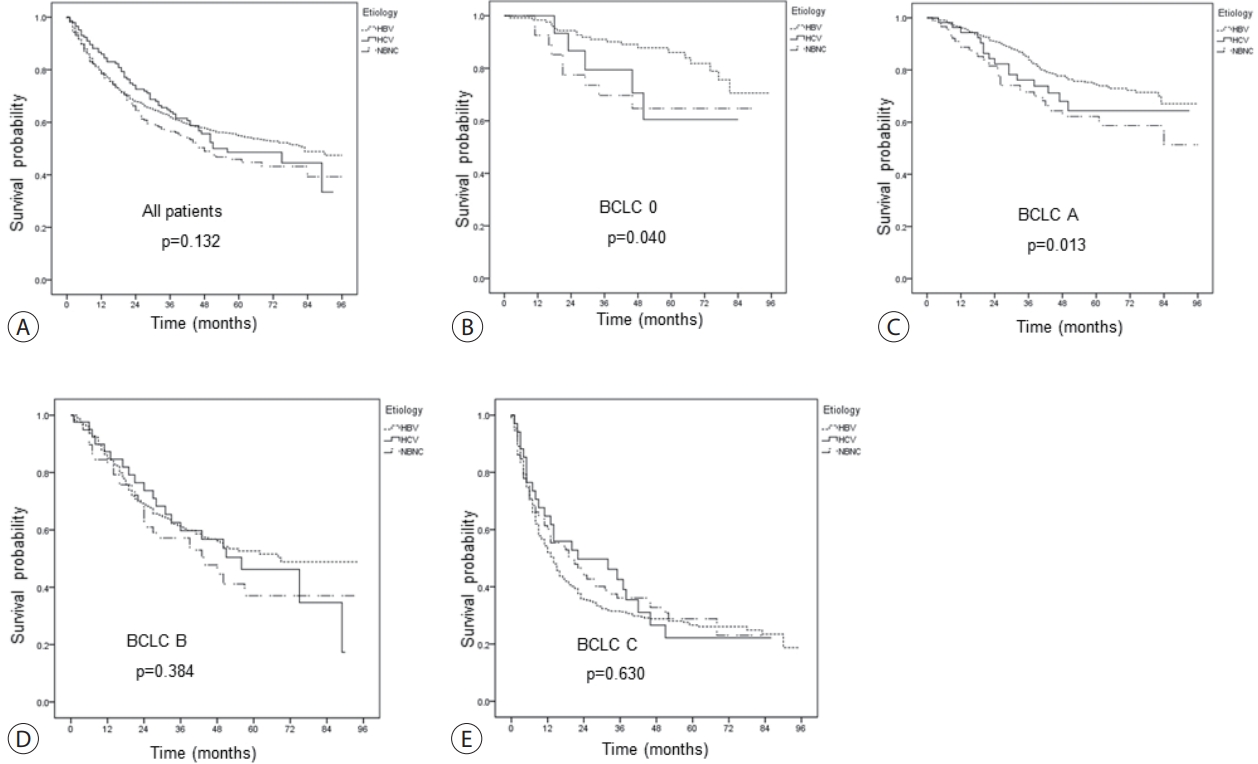Search
- Page Path
- HOME > Search
Original Article
- Clinical characteristics and prognosis of Korean patients with hepatocellular carcinoma with respect to etiology
- Wonjoon Jang, Hye Won Lee, Jae Seung Lee, Beom Kyung Kim, Seung Up Kim, Jun Yong Park, Sang Hoon Ahn, Do Young Kim
- J Liver Cancer. 2022;22(2):158-166. Published online September 27, 2022
- DOI: https://doi.org/10.17998/jlc.2022.09.18

- 2,732 Views
- 65 Downloads
- 7 Citations
-
 Abstract
Abstract
 PDF
PDF Supplementary Material
Supplementary Material - Background/Aim
The profile of patients with hepatocellular carcinoma (HCC) has changed globally; the role of etiology in predicting prognosis of HCC patients remains unclear. We aimed to analyze the characteristics and prognosis of Korean patients with HCC according to disease etiology.
Methods
This retrospective observational study included patients diagnosed with HCC between 2010 and 2014 in a single center in Korea. Patients with HCC aged <19 years old, had coinfection with other viral hepatitis, had missing follow-up data, were Barcelona Clinic Liver Cancer stage D, or died before 1 month were excluded.
Results
A total of 1,595 patients with HCC were analyzed; they were classified into the hepatitis B virus (HBV) group (1,183 [74.2%]), hepatitis C virus (HCV) group (146 [9.2%]), and non-B non-C (NBNC) group (266 [16.7%]). The median overall survival of all patients was 74 months. The survival rates at 1, 3, and 5 years were 78.8%, 62.0% and 54.9% in the HBV group; 86.0%, 64.0%, and 48.6% in the HCV group; and 78.4%, 56.5%, and 45.9% in the NBNC group, respectively. NBNC-HCC has a poorer prognosis than other causes of HCC. Survival was significantly longer in the HBV group with early-stage HCC than in the NBNC group. Furthermore, survival was shorter in patients with early-stage HCC and diabetes mellitus (DM) than in those without DM.
Conclusions
The etiology of HCC affected clinical characteristics and prognosis to some extent. NBNC-HCC patients showed shorter overall survival than viral-related HCC patients. Additionally, the presence of DM is an additional important prognostic factor in patients with early-stage HCC. -
Citations
Citations to this article as recorded by- The Epidemiology of Hepatitis B Virus Infection in Korea: 15-Year Analysis
Log Young Kim, Jeong-Ju Yoo, Young Chang, Hoongil Jo, Young Youn Cho, Sangheun Lee, Dong Hyeon Lee, Jae Young Jang
Journal of Korean Medical Science.2024;[Epub] CrossRef - Comparison of Surgical Resection and Radiofrequency Ablation in Elderly Patients with Hepatocellular Carcinoma
Jun Il Kim, Jayoun Lee, Gi Hong Choi, Min Woo Lee, Dong Ah Park, Jeong-Ju Yoo
Digestive Diseases and Sciences.2024; 69(3): 1055. CrossRef - Focal Segmental Glomerulosclerosis Followed by Acute Hepatitis A Infection: Case Report
Min-Woo An, Jeong-Ju Yoo, Jin Kuk Kim, Ahrim Moon, Sang Gyune Kim, Young Seok Kim
Medicina.2023; 59(5): 819. CrossRef - Validation of MELD 3.0 scoring system in East Asian patients with cirrhosis awaiting liver transplantation
Jeong-Ju Yoo, Jong-In Chang, Ji Eun Moon, Dong Hyun Sinn, Sang Gyune Kim, Young Seok Kim
Liver Transplantation.2023; 29(10): 1029. CrossRef - A nationwide study on the current treatment status and natural prognosis of hepatocellular carcinoma in elderly
Jeong-Ju Yoo, Jayoun Lee, Gi Hong Choi, Min Woo Lee, Dong Ah Park
Scientific Reports.2023;[Epub] CrossRef - Statin use and the risk of hepatocellular carcinoma among patients with chronic hepatitis B: an emulated target trial using longitudinal nationwide population cohort data
Dong Hyun Sinn, Danbee Kang, Yewan Park, Hyunsoo Kim, Yun Soo Hong, Juhee Cho, Geum-Youn Gwak
BMC Gastroenterology.2023;[Epub] CrossRef - Addition of Kidney Dysfunction Type to MELD-Na for the Prediction of Survival in Cirrhotic Patients Awaiting Liver Transplantation in Comparison with MELD 3.0 with Albumin
Kyeong-Min Yeom, Jong-In Chang, Jeong-Ju Yoo, Ji Eun Moon, Dong Hyun Sinn, Young Seok Kim, Sang Gyune Kim
Diagnostics.2023; 14(1): 39. CrossRef
- The Epidemiology of Hepatitis B Virus Infection in Korea: 15-Year Analysis

Case Report
- A Case of Primary Parasternal Abscess in a Cirrhotic and Diabetic Patient with Hepatocellular Carcinoma
- Ji Young Lee, Joo Hyun Sohn, Tae Yeob Kim, Jung Hoon Lee, Ki Sul Chang, Hye Young Lee, Hyo Young Lee
- Journal of the Korean Liver Cancer Study Group. 2013;13(2):164-168. Published online September 30, 2013
- DOI: https://doi.org/10.17998/jlc.13.2.164
- 882 Views
- 0 Download
-
 Abstract
Abstract
 PDF
PDF - Parasternal abscess is usually related to cardiac surgery, trauma or IV drug use and curable with antibiotics and surgical drainage. Sternal metastasis or primary parasternal abscess in a patient with hepatocellular carcinoma (HCC) is much rare and the differentiation between two diseases is occasionally difficult. Herein, we report a patient with HCC, diabetes mellitus and a spontaneously occurred parasternal abscess that is initially confused with a sternal metastasis. A-57-year-old man was admitted due to a slowly growing parasternal mass for 2 months. Two years prior to the admission, he had been diagnosed with small (1.6 cm) HCC in segment VII related to chronic hepatitis Band liver cirrhosis and treated with radiofrequency thermal ablation (RFTA). One year after RFTA, small (1.7 cm) HCC recurred in segment I and then he received TACE twiceat interval of 2 months. Eight months after that, multinodular HCCs newly developed in segment V and VIII (TNM stage IIIA) and two times of additional TACE were given. Thereafter he complained of gradually protruding mass with focal redness and mild tenderness on the sternum. But he denied any febrile and chilling sensation. Dynamic CT scans showed an enhanced parasternal lesion with bone destruction, while a bone scan displayed an increased uptake in the same site, resulting in an indistinguishable lesion between an abscess and a sternal metastasis of HCC. An excisional biopsy was performed on the lesion and revealed an abscess with sternal osteomyelitis rather than sternal metastasis. It was cured with surgical excision and antibiotics without complications.


 E-submission
E-submission THE KOREAN LIVER CANCER ASSOCIATION
THE KOREAN LIVER CANCER ASSOCIATION

 First
First Prev
Prev



 Follow JLC on Twitter
Follow JLC on Twitter